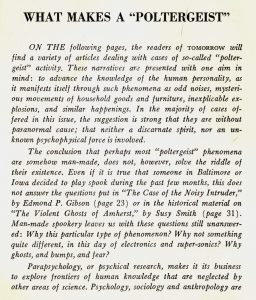Many theories have tried to explain poltergeist activity. Sometimes, physical forces such as magnetism were thought to be the cause. Paranormal skeptics were likely to consider the possibility of a hoax. Parapsychologists were unsatisfied with many of these theories, as they are interested in explaining the “why” of psychic phenomena and examining the unknown of human consciousness and existence. One theory, promoted by parapsychologist Nandor Fodor, suggested that poltergeists were a creation of the human subconscious, an externalization of inner struggle.
See: What is Parapsychology?
“What Makes a ‘Poltergeist'”, in Tomorrow, Vol. 8, No. 2, Spring 1960, Folder “Baltimore Poltergeist,” Box D, Eileen J. Garrett Parapsychology Foundation Collection, Collection 331, Special Collections, University of Maryland, Baltimore County (Baltimore, MD).

